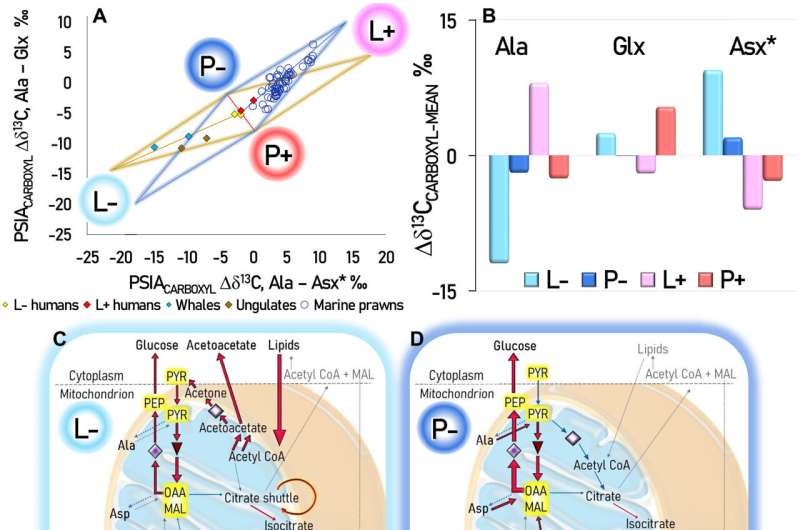This article has been reviewed according to Science X's editorial process and policies. Editors have highlighted the following attributes while ensuring the content's credibility:
fact-checked
peer-reviewed publication
trusted source
proofread
Metabolic strategies found to be consistent across the animal kingdom

Griffith-led research is revealing metabolic strategies that are surprisingly consistent across the rich diversity of life in the animal kingdom.
Published in Science Advances this research shows that despite their outward differences, animals share strategies of mitochondrial metabolism, the energy-producing chemical reactions inside cells.
"Using a carbon isotope approach called 'Isotomics,' the team investigated how metabolism changes in animals, using chemical signals (13C/12C ratios) from the carbon of the most active amino acids during metabolism," said Emeritus Professor Brian Fry from the Australian Rivers Institute.
"We used the Isotomics method to fingerprint metabolism and metabolic strategies across a diverse group of eukaryotic organisms including humans, hoofed animals, whales, and a host of fish and invertebrate species.
"We discovered common biochemical fingerprints for metabolism in major life phases such as growth and reproduction, that were based on isotope values of amino acids, fats and carbohydrates."
This research is the first step in cracking the isotope code for metabolism. Like the genetic code that revealed the fundamental blueprints of life several decades ago, Isotomics reveals the fundamental biochemical pathways of life.
"There is an as yet untapped ocean of metabolic Isotomics knowledge that this study has broken the code to and that we can now begin to access," Professor Fry said.
"Our new Isotomics technique was very reliable, tracing well-known differences between male vs. females, young vs. old, and one species vs. another."

Some of the species were similar in surprising ways. For example the metabolic fingerprints of oysters and humans were very close because both had very balanced metabolism.
"Using carbon isotopes we traced an animals diet, its metabolic response to the diet, and how diets influence health at a fundamental level," Professor Fry said.
""This ground-breaking technique can teach us a lot about how various animals produce the energy they need.
"Our results show that mammals like humans for example, use fats as a pantry for thermal regulation in a very extensive endothermic metabolism, while fish and prawns in Moreton Bay did something dramatically and unexpectedly different. They grew fast but then cannibalized their proteins to make reproductive lipids in a boom-and-bust metabolism."
By setting the groundwork for what we could consider normal present-day metabolism, the future applications of this technology could include investigating abnormal metabolism for hidden problems or early warning indicators for human metabolism involved in diseases like cancer.
"This technology could open up a vast array of exciting areas of research," Professor Fry said. "We can look into how metabolism fingerprints diet-related conditions like obesity or starvation, with police already having shown a definite interest in forensic cases of people held in conditions of forced starvation.
"We can also investigate how metabolism changed in the past by looking at bone protein collagen samples from ancient humans and other animals."
This research also has implications for future wildlife studies. "We can look for similar metabolic problems or general differences in metabolic strategies that help track other organisms responses to human induced stressors like climate change or excess nutrients in waterways which leads to algal blooms," said Dr. Kaitlyn O'Mara, a co-author and research fellow at the Australian Rivers Institute.
More information: Brian Fry et al, Fingerprinting eukaryotic metabolism across the animal kingdom using position-specific isotope analysis (PSIA) 13 C/ 12 C measurements, Science Advances (2023). DOI: 10.1126/sciadv.adg1549
Journal information: Science Advances
Provided by Griffith University





















